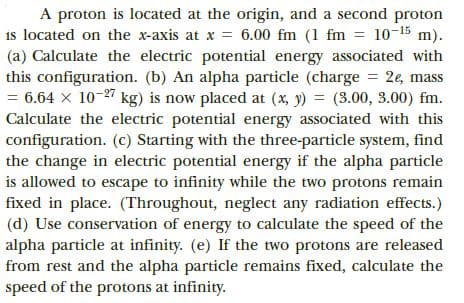A proton is located at the origin, and a second proton is located on the x-axis at x = 6.00 fm (1 fm = 10-15 m). (a) Calculate the electric potential energy associated with this configuration. (b) An alpha particle (charge = 2e, mass = 6.64 x 10-27 kg) is now placed at (x, y) = (3.00, 3.00) fm. Calculate the electric potential energy associated with this configuration. (c) Starting with the three-particle system, find the change in electric potential energy if the alpha particle is allowed to escape to infinity while the two protons remain fixed in place. (Throughout, neglect any radiation effects.) (d) Use conservation of energy to calculate the speed of the alpha particle at infinity. (e) If the two protons are released from rest and the alpha particle remains fixed, calculate the speed of the protons at infinity.
A proton is located at the origin, and a second proton is located on the x-axis at x = 6.00 fm (1 fm = 10-15 m). (a) Calculate the electric potential energy associated with this configuration. (b) An alpha particle (charge = 2e, mass = 6.64 x 10-27 kg) is now placed at (x, y) = (3.00, 3.00) fm. Calculate the electric potential energy associated with this configuration. (c) Starting with the three-particle system, find the change in electric potential energy if the alpha particle is allowed to escape to infinity while the two protons remain fixed in place. (Throughout, neglect any radiation effects.) (d) Use conservation of energy to calculate the speed of the alpha particle at infinity. (e) If the two protons are released from rest and the alpha particle remains fixed, calculate the speed of the protons at infinity.
College Physics
10th Edition
ISBN:9781285737027
Author:Raymond A. Serway, Chris Vuille
Publisher:Raymond A. Serway, Chris Vuille
Chapter16: Electrical Energy And Capacitance
Section: Chapter Questions
Problem 19P: A proton is located at the origin, and a second proton is located on the x-axis at x = 6.00 fm (1 fm...
Related questions
Question
100%

Transcribed Image Text:A proton is located at the origin, and a second proton
is located on the x-axis at x = 6.00 fm (1 fm = 10-15 m).
(a) Calculate the electric potential energy associated with
this configuration. (b) An alpha particle (charge = 2e, mass
= 6.64 x 10-27 kg) is now placed at (x, y) = (3.00, 3.00) fm.
Calculate the electric potential energy associated with this
configuration. (c) Starting with the three-particle system, find
the change in electric potential energy if the alpha particle
is allowed to escape to infinity while the two protons remain
fixed in place. (Throughout, neglect any radiation effects.)
(d) Use conservation of energy to calculate the speed of the
alpha particle at infinity. (e) If the two protons are released
from rest and the alpha particle remains fixed, calculate the
speed of the protons at infinity.
Expert Solution
This question has been solved!
Explore an expertly crafted, step-by-step solution for a thorough understanding of key concepts.
This is a popular solution!
Trending now
This is a popular solution!
Step by step
Solved in 4 steps with 4 images

Recommended textbooks for you

College Physics
Physics
ISBN:
9781285737027
Author:
Raymond A. Serway, Chris Vuille
Publisher:
Cengage Learning

Physics for Scientists and Engineers: Foundations…
Physics
ISBN:
9781133939146
Author:
Katz, Debora M.
Publisher:
Cengage Learning

Physics for Scientists and Engineers, Technology …
Physics
ISBN:
9781305116399
Author:
Raymond A. Serway, John W. Jewett
Publisher:
Cengage Learning

College Physics
Physics
ISBN:
9781285737027
Author:
Raymond A. Serway, Chris Vuille
Publisher:
Cengage Learning

Physics for Scientists and Engineers: Foundations…
Physics
ISBN:
9781133939146
Author:
Katz, Debora M.
Publisher:
Cengage Learning

Physics for Scientists and Engineers, Technology …
Physics
ISBN:
9781305116399
Author:
Raymond A. Serway, John W. Jewett
Publisher:
Cengage Learning

Principles of Physics: A Calculus-Based Text
Physics
ISBN:
9781133104261
Author:
Raymond A. Serway, John W. Jewett
Publisher:
Cengage Learning


College Physics
Physics
ISBN:
9781305952300
Author:
Raymond A. Serway, Chris Vuille
Publisher:
Cengage Learning